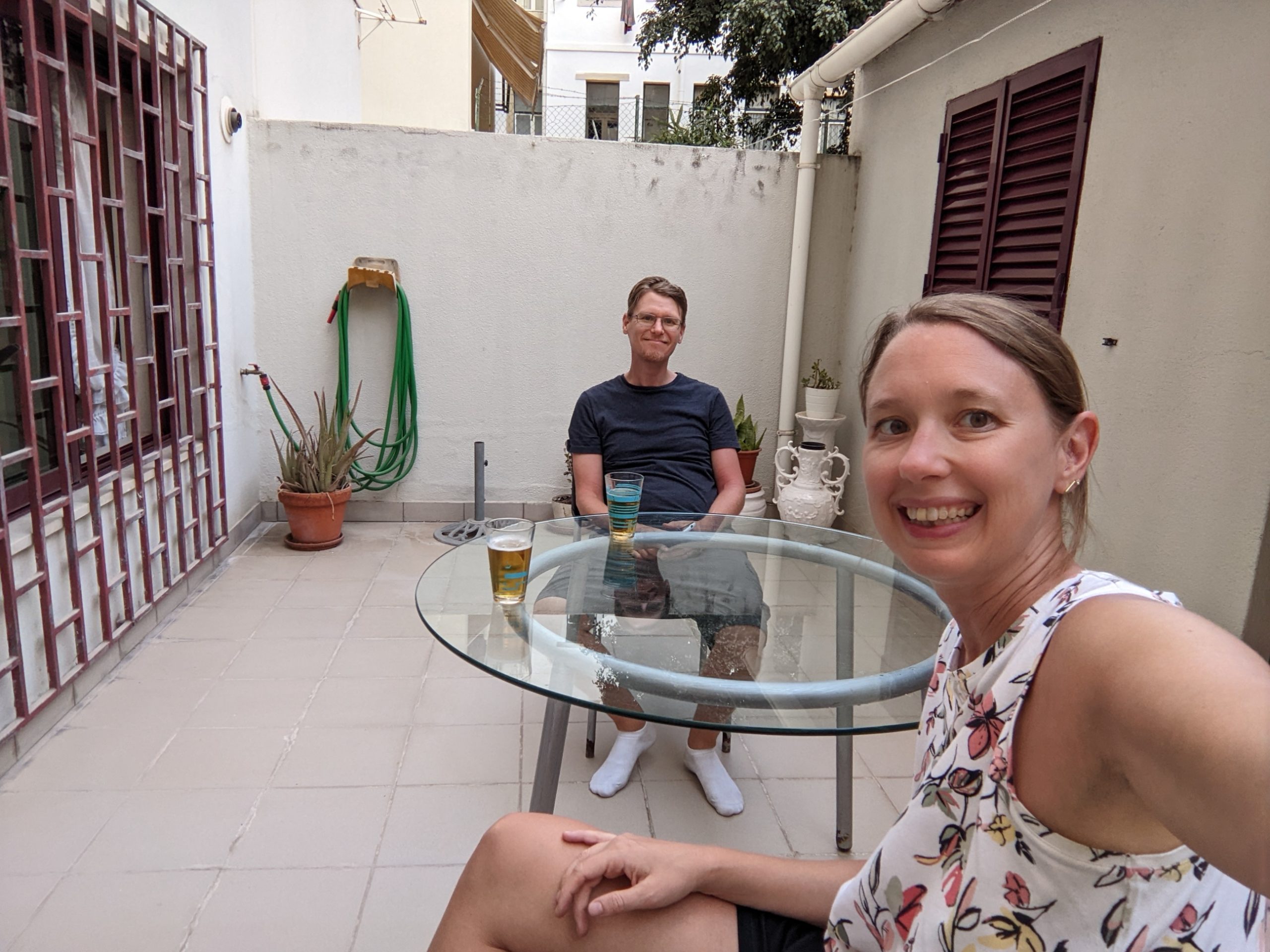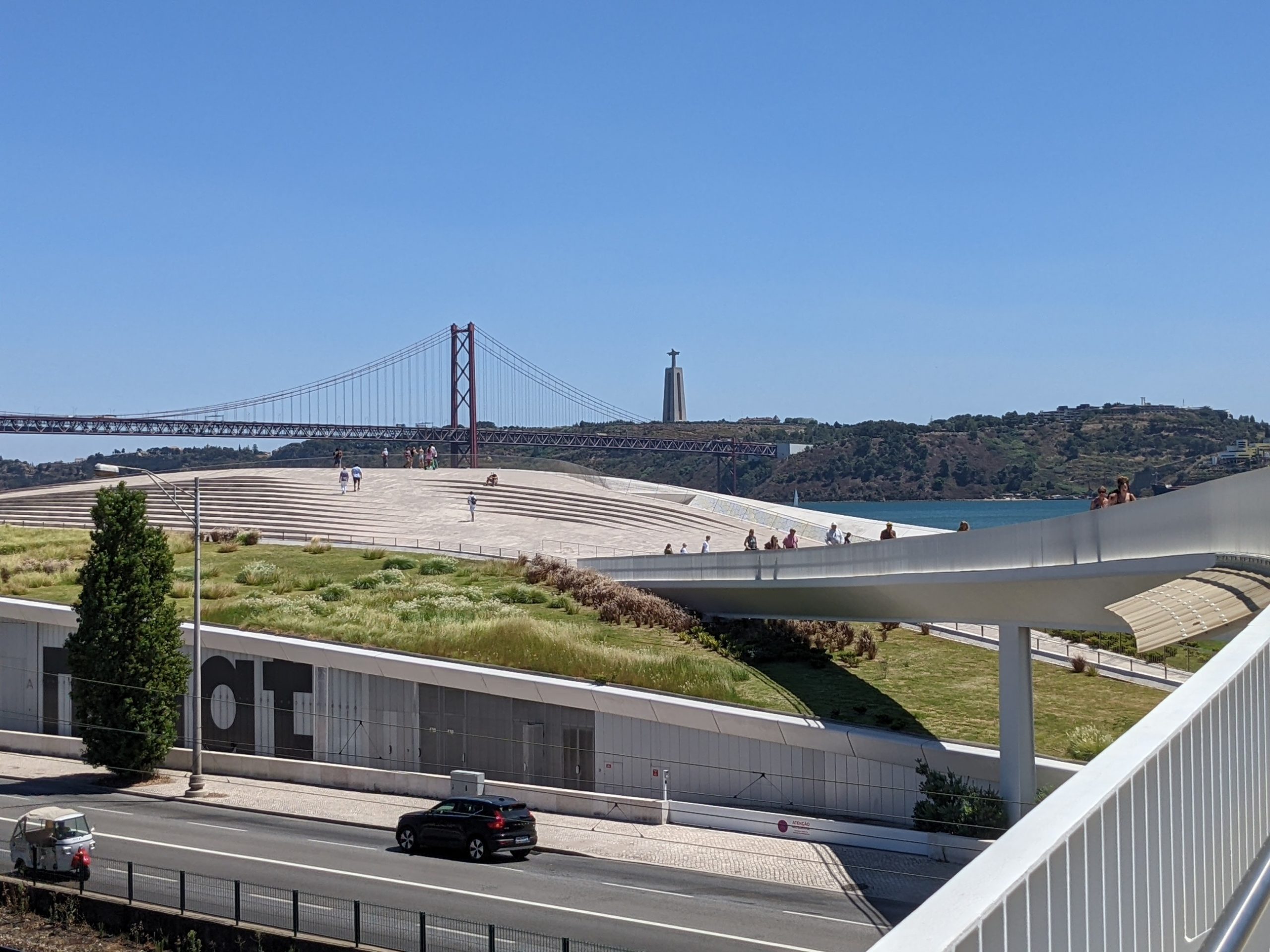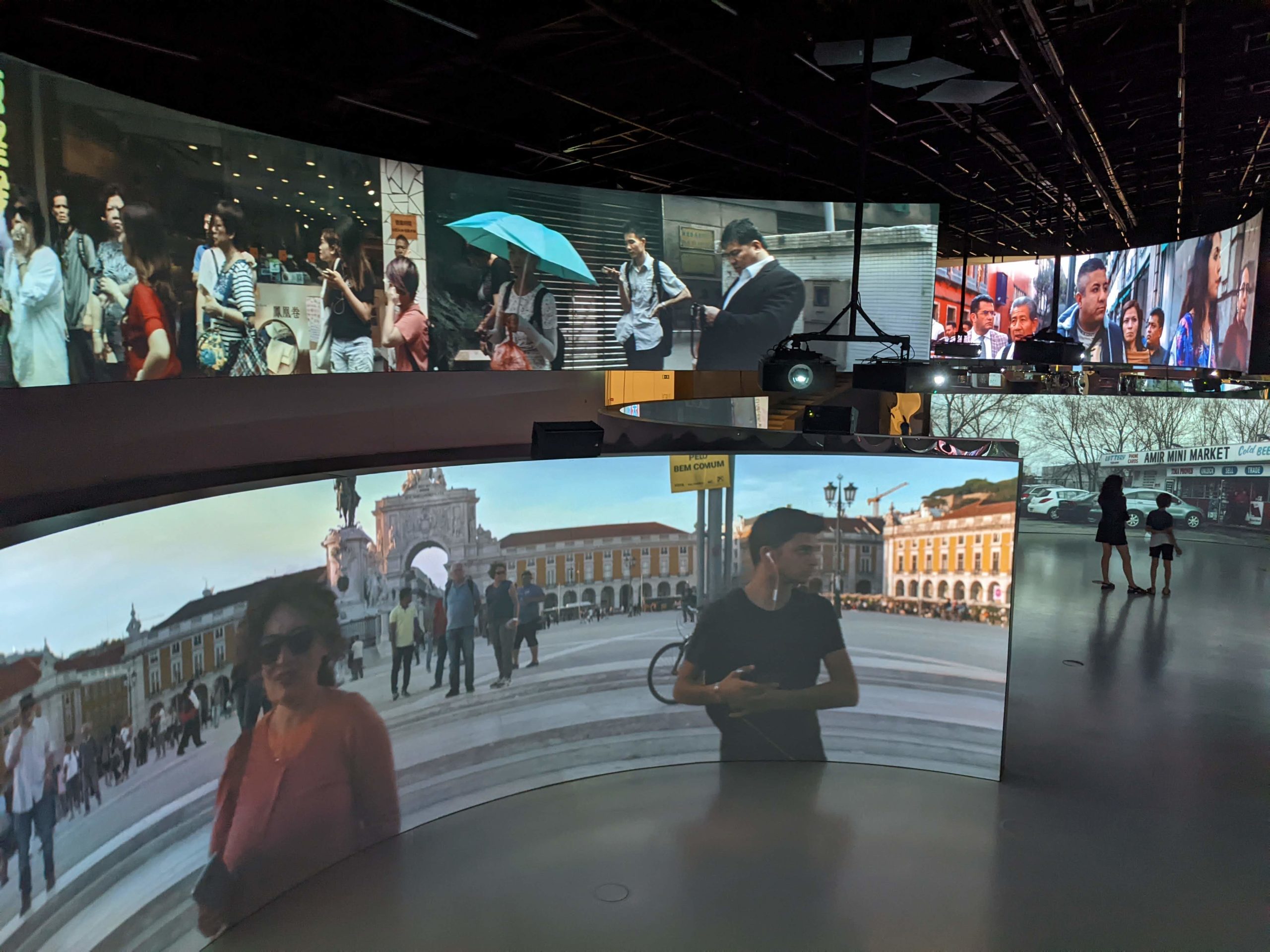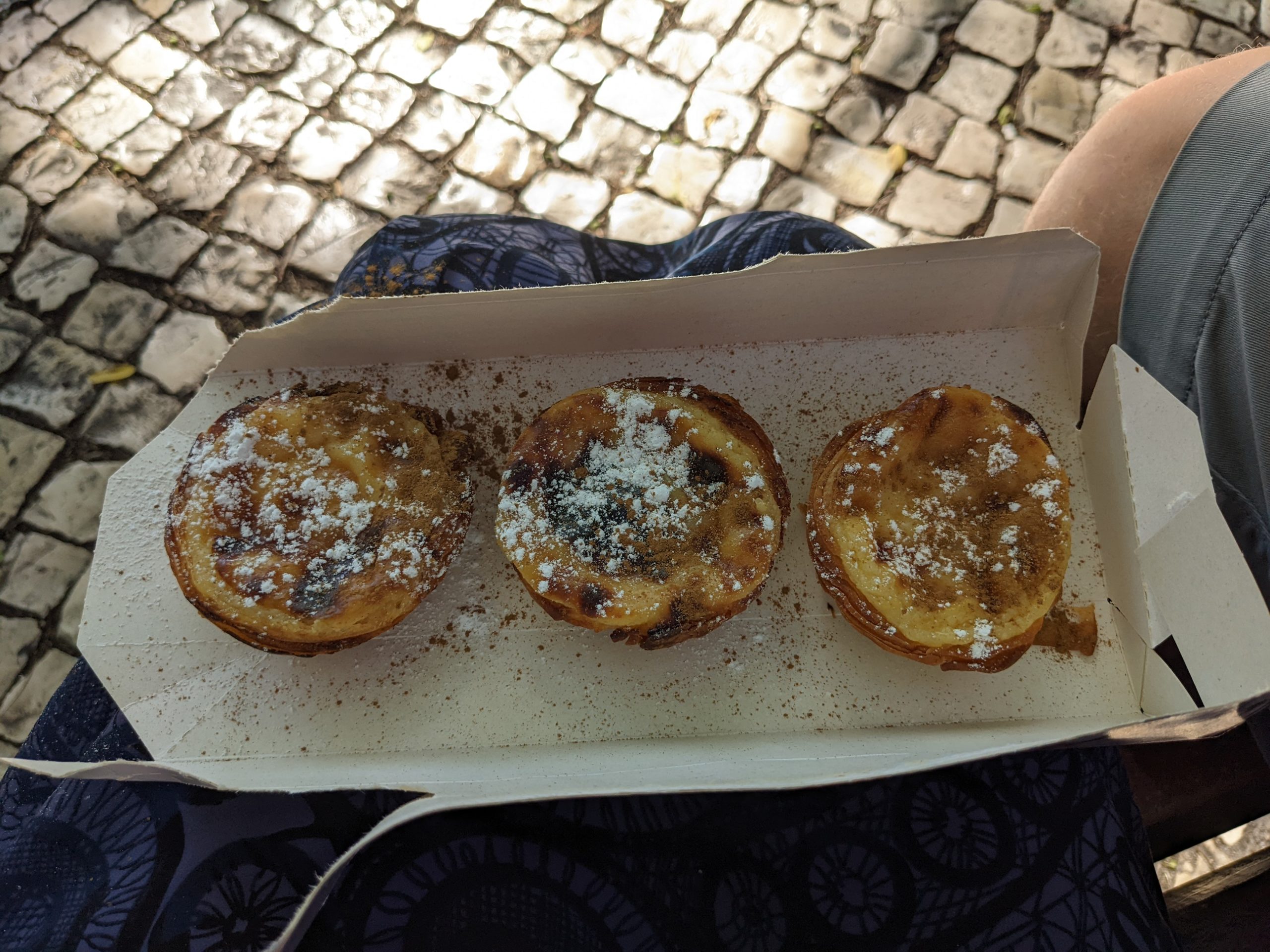While Faro was a great introduction to Portugal, we really started to understand the country during our week in Lisbon. It began with a great start – a cheap and easy Uber ride from the train station to our Airbnb apartment where we met our host (review below). The apartment was spacious, clean, and had a great back terrace, though it was unusable during the day due to construction at the apartment next door. But it was really nice for having our dinners on, or an evening drink. And our host was very friendly and apologetic and provided a wonderful welcome gift for us of wine, cheese, jam, toast, and pastries. We never expect something like that from an Airbnb host, but it is always appreciated when they go over and above in that way.





After all of our fun in Seville and Faro we were a little burned out on sightseeing in Lisbon. But, we still managed several fun experiences during our weeklong stay.
Touring Day – Audio Tour, Alfama, and the Pharmacy Museum
When we finally felt like getting out as tourists, we wanted to make the most of our time. We used the metro to get down to the riverfront at the Praça do Comércio (Commerce Plaza). We weren’t too impressed with Lisbon’s metro system – the trains were less frequent than it takes to make a metro system really work (8 to 10 minutes apart in the main part of the day). But it was convenient and not too expensive. We bought two transit cards with four rides a piece and that served us for our one-week stay. We never tried the bus in Lisbon because those times seemed infrequent too. Odd for such a large city, but probably explains why the traffic is such a challenge there.
We’d enjoyed our Voice Map audio tour so much in Ronda that I downloaded another, this time with a theme of Lisbon’s historic neighborhoods. The tour began at the Arco da Rua Augusta on the plaza and took us to many interesting locations in Baixa (downtown). We learned a lot about the history of Lisbon and of Portugal in the tour – the stories really made it. The tour ended in the neighborhood of Graça, which is up the hill and features many beautiful overlooks of the city and the river.












From there we walked down into the Alfama neighborhood, which wasn’t covered in the audio tour but is the main old neighborhood of Lisbon with steep narrows streets and a streetcar that goes through. We stopped at a cafe and tried a few Portuguese pastries, including the pastel de nata (also known as the pastel de Belem; more on that below). Portugal is known for its pastries and from this first taste we made it a priority to go out to a cafe at least once a week for more. We also tried Ginja at the cafe, the traditional Portuguese liqueur made from ginja berries (tastes like cherry).





From there we decided a museum was in order and we chose the Museu da Farmácia. It was back by the Chiado and Barro Alto neighborhoods that we’d seen on our walking tour and found to be charming. We took an Uber there to save our legs and had a very interesting conversation with the driver about the pandemic’s effects on Portugal. Like most places, the tourism industry was hit hard and was still in the process of recovering. The Uber driver had been a private driver and tour operator for hotels and was still only able to work part-time at that. He was very happy that Portugal was having such a busy summer of tourism.
The Pharmacy Museum was interesting and quite well done, especially the downstairs displays created from the vintage items from early Lisbon pharmacies and one model of a pharmacy in Macau, an area of China that was a Portuguese territory until 1999. After the museum we found a very traditional Portuguese seafood lunch nearby. It was a fun day and we felt like we learned a lot.









Visit to MAAT Museum and Belem
A couple days later, we were ready for another outing. This time we worked through the morning and went out after lunch. Luckily the weather in Portugal is typically temperate enough that you don’t have to try to avoid going out in the afternoons.
We walked down the Avenida da Liberdade to the Praça da Figueira to catch the 15E tram over to Belem. This tram was not like the historic yellow ones in Belem, but a nice modern one. When the tram let us out, we walked over a bridge over to the train tracks to the Museum of Art, Architecture, and Technology. It includes a modern building with art installations and an old power station where they have exhibits about electricity and some additional art. We started at the power station and it was fascinating, but our favorite part was a huge video installation in the main MAAT building about city life. It was remarkably immersive and trippy.













From the museum we walked into the heart of the Belem district, which is sort of a suburb of Lisbon. It is known for being where the pasteis de nata were invented by monks at a monastery located there. There is a cafe called Pastéis de Belém that claims to use the original recipe. It serves thousands of them a day, so Chad and I stopped by and picked up three to enjoy in a park. They were very tasty and it is a neat tradition.
We saw the parks and then walked down to the riverfront to see a couple of monuments, including one for Vasco de Gama, the Portuguese explorer who sailed all the way to India and made Portugal a center for European trade. We found a cute little food truck to enjoy some tapas and drinks while watching the river then ended our fun day by taking the tram and metro back to our neighborhood for a very tasty Indian dinner.




Parque Florestal de Monsanto and other parks
On our final day in Lisbon, we wanted to get out of the city. The neighborhood we chose near Parque Eduardo VII (which was wonderful) had a lot of traffic and it was hard to get many walks in because we had to wait so long for the lights at crosswalks. We identified a big city park to the west, packed a picnic and our hiking sticks, and took an Uber out there (actually probably a Bolt, which is an Uber competitor; we found there tended to be greater availability and lower prices on that app, but generally checked both anytime we wanted a ride somewhere).
We had a wonderful hike and enjoyed our picnic a lot. We hadn’t seen much nature since Ronda and even there it was mostly farmland and vineyards. The park proved to be a perfect end to our time in Lisbon.




Living near Parque Eduardo VII was also very nice. We had an evening picnic there early in our stay that was really lovely with all the nice snacks provided by the host, plus some smoked salmon and later had the leftovers for a picnic lunch there. Chad ran there most days and I’d walk there with him and read my book under the trees. If it hadn’t been for all the traffic and the sporadic public transportation, the neighborhood would have been perfect for us. Luckily the park itself was well protected from the noise and was very peaceful. It was easy to see why there were always lots of people walking through and lounging in the grass.


Summary
One big question we had was whether we’d prefer Lisbon or Porto. Now that we’ve had our full month in Porto, I can say it wins for us without question. We left Lisbon hoping Porto would be better than Lisbon about traffic, public transit, and crowds. It definitely was. We’re glad we picked Porto for our longer stay in Portugal but are very glad we chose to spend a full week in Lisbon. It’s a great European capital and we had a really great week there.
Lisbon Airbnb Review – The apartment is even larger than it looks in the photos, clean and comfortable. Very convenient to Parque Eduardo VII, which became our favorite place in Lisbon. Easy to get to everything else via transit. Wifi worked well and the kitchen was stocked for light cooking. The terrace was an unexpected bonus. Diogo, the host, is extremely kind and helpful and provided lovely snacks when we arrived. We really enjoyed our one-week stay here.